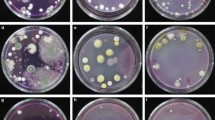Abstract
Some 25 fungi, including at least 14 basidiomycetes, one ascomycete, and five anamorphic fungi were evaluated for their cellulose-degrading abilities in Difco potato dextrose broth or Difco malt extract broth cultures with cellulosic substrates (e.g., filter paper) in plastic Petri dishes. Among them, Peniophora sp. 06-13 and Phlebia sp. 99-335 reduced the dry weights of the whole cultures with these substrates more than the dry weights of the respective original substrates after 30 days of culture, showing definite cellulose degradation. In the cultures with more than 10 test fungi including Pycnoporus coccineus 84-117, such weight losses did not occur. This assay technique for the primary screening for cellulose degrading fungi is simple, inexpensive, reproducible and accurate.




Similar content being viewed by others
References
Crawford DL, Crawford RL, Pometto Al III (1977) Preparation of specifically labelled 14C-(lignin)- and 14C-(cellulose)-lignocelluloses and their decomposition by the microflora of soil. Appl Environ Microbiol 33:1247–1251
Dashtban M, Maki M, Leung KT, Mao C, Qin W (2010) Cellulase activities in biomass conversion: measurement methods and comparison. Critical Rev Biotech 30:302–309
Deacon JW (1985) Decomposition of filter paper cellulose by thermophilic fungi acting singly, in combination, and in sequence. Trans Br Mycol Soc 85:663–669
Denison DA, Koehn RD (1977) Cellulase activity of Poronia oedipus. Mycologia 69:592–603
Garrett SD (1962) Decomposition of cellulose in soil by Rhizoctonia solani Kühn. Trans Br Mycol Soc 45:115–120
Geng X, Li K (2002) Degradation of non-phenolic lignin by the white-rot fungus Pycnoporus cinnabarinus. Appl Microbiol Biotech 60:342–346
Sato A, Watanabe T, Watanabe Y, Harazono K, Fukatsu T (2002) Screening for basidiomycetous fungi capable of degrading 2,7-dichlorodibenzo-p-dioxin. FEMS Microbiol Lett 213:213–217
Singh N, Kunene IS (1980) Cellulose decomposition by four isolates of Pyricularia oryzae. Mycologia 72:182–190
Sutherland JB (1984) Biodegradation of lignocelluloses from cotton-gin trash by Pycnoporus cinnabarinus. Mycologia 76:369–372
Sutherland JB, Pometto AL III, Crawford DL (1983) Lignocellulose degradation by Fusarium species. Can J Bot 61:1194–1198
Tanesaka E, Masuda H, Kinugawa K (1993) Wood degrading ability of basidiomycetes that are wood decomposers, litter decomposers, or mycorrhizal symbionts. Mycologia 85:347–354
Wabnegg F, Messner K, Röhr M (1980) A screening method for the estimation of filter paper activity. J Gen Microbiol 117:267–269
Watanabe T (2010) Pictorial atlas of soil and seed fungi, 3rd edn. CRC, Boca Raton
Watanabe T, Watanabe Y, Nakamura K (2003) Biodegradation of wood in dual cultures of selected two fungi determined by chopstick method. J Biosci Biotech 95:623–626
Watanabe T, Tagawa M, Tamaki H, Hanada S (2011) Coprinopsis cinerea from rice husks forming sclerotia in agar culture. Mycoscience 52:152–156
Author information
Authors and Affiliations
Corresponding author
About this article
Cite this article
Watanabe, T., Kanno, M., Tagawa, M. et al. Primary simple assays of cellulose-degrading fungi. Mycoscience 53, 45–48 (2012). https://doi.org/10.1007/s10267-011-0132-5
Received:
Accepted:
Published:
Issue Date:
DOI: https://doi.org/10.1007/s10267-011-0132-5




